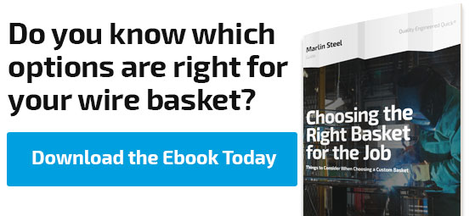 Custom steel wire baskets are Marlin Steel’s bread and butter. Every week, Marlin creates custom wire baskets that go to clients all over the world. However, Marlin’s degreed engineers have noticed that many customers seem to have a few common misconceptions about wire baskets.
Custom steel wire baskets are Marlin Steel’s bread and butter. Every week, Marlin creates custom wire baskets that go to clients all over the world. However, Marlin’s degreed engineers have noticed that many customers seem to have a few common misconceptions about wire baskets.
These misconceptions have lead some customers to order baskets that didn’t fully meet their needs in the past. In fact, many of Marlin’s customers came to Marlin to fix a problem with their old basket design that they ordered elsewhere. Many of these issues arose because of some misunderstanding about what was needed in the basket’s design.
To help you avoid similar problems, here are a few of the common misconceptions about wire baskets that Marlin’s degreed engineers have encountered in the past:
#1: Buying a Cheaper Basket Will ALWAYS Save Money
Many businesses try to cut costs and save money by buying the cheapest basket available. At first, it sounds like a great idea. However, a cheaper basket doesn’t always save money in the long run.
For example, if a company using a wire basket for parts washing applications were to try and save money by using a basket made from plain steel rather than stainless steel, their upfront costs would be reduced. Unfortunately, though, plain steel baskets would be quickly corroded by the chemicals used in a parts washing process. This would reduce the useful life of the basket, and possibly risk damage to the parts being washed.
On the other hand, stainless steel would withstand exposure to the mild corrosives used in parts washing processes for much longer. Rather than lasting mere months, these baskets would last for years.
Think about it this way, if one basket cost $25, but you had to replace it 4 times a year, would it still be less expensive to your company than buying a $100 basket that could last for the better part of a decade?
#2: All Stainless Steels are the Same
There are many different types of stainless steel alloy, from common alloys such as grade 304 stainless steel, to less common alloys such as grade 420 stainless steel.
Each of these alloys have different properties from the rest. Some alloys possess a higher tensile strength, stronger corrosion resistance, or even higher temperature resistance than others.
These characteristics affect how well a metal storage container or parts washing basket might perform in different situations. For example, a basket made of grade 330 stainless steel can take temperatures up to 1,900 degrees Fahrenheit (940 degrees Celsius) without losing too much of its tensile strength, making it ideal for heat treating applications. Other steel alloys, when exposed to such high temperatures, will lose much of their tensile strength, causing parts loads to deform the container much more easily.
#3: Each Basket Has to Be Custom-Built for Each Part/Process
While customizing each basket you use to each individual part or process can be helpful in maximizing their performance and longevity, it isn’t always necessary. Depending on your production processes, it’s possible to create a general-purpose wire basket that can be used in multiple processes for multiple parts.
In fact, using a metal container for multiple processes can help save time on the production line. How much time depends on how long it takes your production team to unload parts from one basket to the next, and how often this has to be done.
For example, if the loading/unloading process takes 2 minutes each time, and has to be done three times, that’s six minutes you could save on each load of parts you produce by using a single basket rather than three specialized ones.
However, it’s important to check with an experienced mechanical engineer first to see if using a less specialized basket is feasible for your production process.
#4: Substrate Materials Don’t Matter if the Basket is Fully Coated
In many of the basket designs that Marlin has made, the wire basket would be given a specialized coating material to help improve the basket’s suitability for a given task. For example, soft coatings of PVC or other materials might be used in basket designs meant to hold delicate, no-scratch parts.
However, just because a metal container uses a coating, that doesn’t mean that the material beneath the coating doesn’t matter.
For example, certain non-stick coatings have a very porous surface, allowing chemical compounds to easily penetrate to the material beneath the coating. In such a case, the material below the coating needs to be just as corrosion-resistant as the coating itself.
Also, even if a coating is rated for use in high-temperature applications, the material underneath can still lose tensile strength or even melt if your process’ temperature exceeds its recommended operational limit.
These are just a few of the common misconceptions about steel wire baskets that Marlin’s engineering team have encountered over the years. Taking the time to learn about common custom basket issues can help you make more informed decisions when placing a custom basket order, resulting in a better basket to meet your needs.



.gif)


